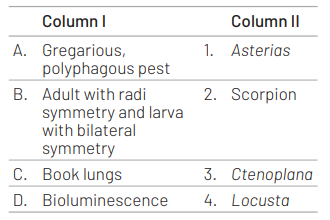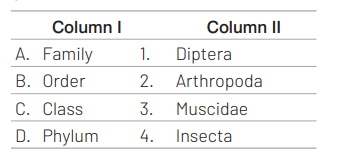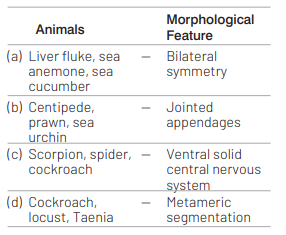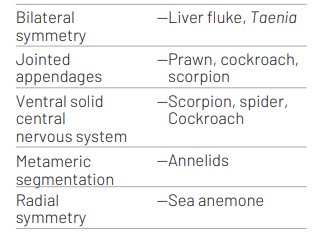Question
Which one of the following belongs to the family-Muscidae? [NEET 2021]
(a) Firefly
(b) Grasshopper
(c) Cockroach
(d) Housefly
Answer/Explanation
Ans. (d)
Housefly belong to Muscidae family. Muscidae are a family of flies found in superfamily-Muscoidea. The family-Muscidae is a large dipteran family comprised of more than 5000 species. Other options can be explained as: Firefly belong to Lampyridae family Grasshopper belong to Acrididae family
Cockroach belong to Blattidae family.
Question
Match the following organisms with their respective characteristics. [NEET (National) 2019]

Select the correct option from the following :
A B C D
(a) (iii) (iv) (ii) (i)
(b) (ii) (iv) (iii) (i)
(c) (iii) (ii) (iv) (i)
(d) (iii) (ii) (i) (iv)
Answer/Explanation
Ans. (a)
(A)Hiii), (B)Hiv), (CH-Hii), (D)-Hi)
Pila or apple snail contains a file-like rasping organ called radula for feeding.
Bombyx or silkworm is an arthropod in which excretion occurs through Malpighian tubules. The body of ctenophore Pleurobranchia bears eight rows of ciliated comb plates, which help in locomotion.
In Taenia, excretion occurs through specialised cells called flame cells which contain a protonephridia.
Question
Which of the following features is not present in the phylum-Arthropoda? [NEET 2016, Phase I]
(a) Metameric segmentation
(b) Parapodia
(c) Jointed appendages
(d)Chitinous exoskeleton
Answer/Explanation
Ans. (b)
Parapodia are present in aquatic annelids like Nereis, which help them in swimming. Other three features, i.e. metameric segmentation, jointed appendages and chitinous exoskeleton are present in phylum-Arthropoda. Out of these metameric segmentation is visible as tagmetisation.
Question
Match column I with column II for housefly classification and select the correct option using the codes given below: [NEET 2016, Phase II]

Codes
A B C D
(a) 3 1 4 2
(b) 3 2 4 1
(c) 4 3 2 1
(d) 4 2 1 3
Answer/Explanation
Ans. (a)
Classification of housefly
A. Family – Muscidae
B. Order-Diptera
C. Class – Insecta
D. Phylum – Arthropoda
Short Trick The question can be easily solved via elimination technique as (D) phylum is given with (2) Arthropoda combination in only option (a). This easily eliminates other options as correct answer. Thus, saves your time too.
Question
Which group of animals belong to the same phylum? [NEET 2013]
(a) Malarial parasite, Amoeba, mosquito
(b) Earthworm, pinworm, tapeworm
(c) Prawn, scorpion, Locusta
(d) Sponge, sea anemone, starfish
Answer/Explanation
Ans. (c)
Prawn, Scarpion, Locusta belong to phylum- Arthropoda therefore, it is correct. Others can be corrected as Malarial parasite (Plasmodium vivax) and Amoeba belong to phylum-Protoza.
Mosquito-Phylum-Arthropoda
Earthworm-Phylum-Annelida
Pinworm and Tapeworm -Phylum-
Aschelminthes
Sponge-Phylum-Porifera, Sea
anemone –
Phylum – Coelenterata
Starfish – Phylum-Echinodermata
Question
One of the representative of Phylum- Arthropoda is [NEET 2013]
(a) cuttle fish
(b) silver fish
(c) puffer fish
(d) flying fish
Answer/Explanation
Ans. (b)
Silver fish – Arthropoda (phylum)
Silver fish is a small, wingless insect in the order Thysanura.
Cuttle fish – Mollusca
Putter fish – Chordata (phylum)
class – Pisces
Flying fish – Pisces.
Question
Which of the following are correctly matched with respect to their taxonomic classification? [NEET 2013]
(a) Flying fish, cuttle fish, silver fish-Pisces
(b) Centipede, millipede, spider, scorpion-Insecta
(c) House fly, butterfly, tse-tse fly, silver fish-Insecta
(d) Spiny anteater, sea urchin, sea cucumber-Echinodermata
Answer/Explanation
Ans. (c)
Option (c) is correctly matched
housefly, butterfly, tse-tse fly, silver fish-Insecta of phylum-Arthropoda.
Others can be corrected as
Flying fish, class – Osteichthyes of phylum – Pisces, cuttle fish (Sepia) of phylum – Mollusca
Silver fish, class-Insecta of phylum
– Arthropoda
Sea urchin and sea cucumber belong to Echinodermata.
Spider and scorpion belong to class
– Arachnida of phylum – Arthropoda.
Centipede belongs to class – Chilopoda of phylum – Arthropoda.
Millipede belongs to class – Diplopeda of phylum – Arthropoda.
Spring anteater belongs to phylum Mammalia.
Question
Which one of the following have the highest number of species in nature? [CBSE AIPMT 2011]
(a) Insects
(b) Birds
(c) Angiosperms
(d) Fungi
Answer/Explanation
Ans. (a)
More than $70 \%$ of all the species recorded are animals. Among animals, insects are the most species rich taxonomic group, making more than $70 \%$ of the total. It means out of every 10 animals on this planet, 7 are insects.
Question
Which of the following is correctly states as it happens in the common cockroach? [CBSE AIPMT 2011]
(a) Oxygen is transported by haemoglobin in blood
(b) Nitrogenous excretory product is urea
(c) The food is ground by mandibles and gizzard
(d) Malpighian tubules are excretory organs projecting out from the colon
Answer/Explanation
Ans. (c)
In cockroach, mandibles are a pair of hard, strong, large, dark coloured triangular, structures which move in horizontal motion and crush food between them.
Gizzard or proventriculus has an outer layer of thick circular muscles and thick inner cuticle forming six highly chitinous plate called teeth. The gizzard acts as the grinding chamber and helps in grinding the food particles.
Question
Which one of the following groups of three animals each is correctly matched with their one characteristic morphological feature? [CBSE AIPMT 2008]

Answer/Explanation
Ans. (c)
Characteristic Animal

Question
Which one of the following is the true description about an animal concerned? [CBSE AIPMT 2008]
(a) Earthworm- The alimentary canal consists of a sequence of pharynx, oesophagus, stomach, gizzard and intestine
(b) Frog – Body divisible into three regions-head, neck and trunk
(c) Rat – Left kidney is slightly higher in position than the right one
(d) Cockroach – 10 pairs of spiracles ( 2 pairs on thorax and 8 pairs on abdomen)
Answer/Explanation
Ans. (d)
The respiratory system of cockroach consists of tracheae, tracheoles and spiracles. The main tracheal trunks open to exterior on body surface through 10 pairs of segmentally arranged spiracles. Two pair of spiracles are thoracic (one between pro and mesothorax and other between meso and metathorax). Eight pairs of spiracle are abdominal (one pair in each of the first eight abdominal segments). Alimentary canal of earthworm is complete and functionally regioned into buccal chamber, pharynx, oesophagus, gizzard, stomach and intestine. Frog’s body has two main parts, i.e., head and trunk. Absence of neck and tail provide convenience in both hopping and swimming.
Question
Which one of the following phyla is correctly matched with its two general characteristics? [CBSE AIPMT 2008]
(a) Arthropoda – Body divided into head, thorax and abdomen and respiration by tracheae
(b) Chordata – Notochord at some stage and separate anal and urinary openings to the outside
(c) Echinodermata – Pentamerous radial symmetry and mostly internal fertilisation
(d) Mollusca – Normally oviparous and development through a trochophore or veliger larva
Answer/Explanation
Ans. (a)
Arthropoda is the largest phylum of animal kingdom. Body of an arthropod is divisible into head, thorax and abdomen. Head and thorax often fused to form cephalothorax. The respiration takes place by general body surface, gills, tracheae or book lungs.
Molluscs are mostly dioecious or monoecious, one or more gonads with gonoducts, opening into renal ducts or to exterior. The fertilisation is external or internal, development direct or indirect through free larval forms. Echinoderms have a pentamerous radial symmetry derived from an original bilateral symmetry. The fertilisation is external, development indirect through free-swimming larval forms.
Chordates are sharply distinguished from non-chordates by presence of notochord, dorsal tubular central nervous system and pharyngeal gills slits.
Question
What is true about Nereis, scorpion, cockroach and silver fish? [CBSE AIPMT 2007]
(a) They all have jointed paired appendages
(b) They all possess dorsal heart
(c) None of them is aquatic
(d) They all belong to the same phylum
Answer/Explanation
Ans. (c)
Nereis living in burrows in sand or mud often with clams. Scorpion are abundant in deserts. Cockroach are found in warmth, dampness and plenty of organic food to devour. Lepisma (silver fish) residing in damp cool places and feeding on starch of starchy matter.
Question
Two common characters found in centipede, cockroach and crab are [CBSE AIPMT 2006]
(a) compound eyes and anal cerci
(b) jointed legs and chitinous exoskeleton
(c) green gland and tracheae
(d) book lungs and antennae
Answer/Explanation
Ans. (b)
Crab, centipede and cockroach belong to phylum-Arthropoda. These have jointed appendages and chitinous exoskeleton.
Question
From the following statements select the wrong one. [CBSE AIPMT 2005]
(a) Millipedes have two pairs of appendages in each segment of the body
(b) Prawn has two pairs of antennae
(c) Animals belonging to phylum-Porifera are exclusively marine
(d) Nematocysts are characteristic of the phylum-Cnidaria
Answer/Explanation
Ans. (b)
Prawn does not have two pairs of antennae instead it has one pair of antennae and one pair of antennules.
Question
In Arthropoda, head and thorax are often fused to form cephalothorax, but in which one of the following classes, is the body divided into head, thorax and abdomen? [CBSE AIPMT 2004]
(a) Insecta
(b) Myriapoda
(c) Crustacea
(d) Arachnida and Crustacea
Answer/Explanation
Ans. (a)
An arthropod body consists of head, thorax and abdomen, in some cases head and thorax may be fused to form cephalothorax. Class-Insecta have body divided into head, thorax and abdomen.
Question
Which one of the following is correct matching pair of an animal and a certain phenomenon it exhibits? [CBSE AIPMT 2003]
(a) Chameleon- Mimicry
(b) Taenia – Polymorphism
(c) Pheretima – Sexual dimorphism
(d) Musca – Complete metamorphosis
Answer/Explanation
Ans. (d)
The young forms of housefly (maggot, pupas) are entirely different from the adult, the metamorphosis being complete(holometabolic metamorphosis). Metamorphosis is a process during which an animal undergoes a comparatively rapid changes from their larval stages to adult form.
Question
What is common among silver fish, scorpion, crab and honeybee? [CBSE AIPMT 1997]
(a) Compound eyes
(b)Poison glands
(c) Jointed appendages
(d) Metamorphosis
Answer/Explanation
Ans. (c)
The main characteristics of phylumArthropoda are as follows
(i) Jointed appendages, present in some or all somite or segments, but often modified for specialised functions like walking, clinging, jumping, etc.
(ii) Bilateral symmetry.
(iii) Exoskeleton of cuticle.
(iv) Complex muscular system.
(v) Reduced coelom.
(vi) Complete digestive system.
(vii) Open circulatory system.
(viii) Respiration by body surface, gills, trachea (air tubes), or book lungs.
(ix) Paired excretory glands called coxal, antennal or maxillary glands present in some, homologous to metameric nephridial system of annelids, some with other excretory organs called Malpighian tubules.
(x) Nervous system with dorsal brain connected by a ring around the gullet to a double nerve chain of ventral ganglia.
(xi) Sexes usually separate.
Question
A larval stage occurs in the life history of all members of the group [CBSE AIPMT 1993]
(a) frog, lizard and cockroach
(b) Ascaris, housefly and frog
(c) housefly, earthworm and mosquito
(d) butterfly, frog and mosquito
Answer/Explanation
Ans. (d)
Lizard, cockroach, Ascaris, earthworm shows direct development in their life cycle. Whereas, butterfly have catterpillar, frog have tadpole and mosquito have wriggler larvae in their life cycle.
Question
Adult Culex and Anopheles can be distinguished with the help of [CBSE AIPMT 1992]
(a) mouth parts/colour
(b) sitting posture
(c) antennae/wings
(d) feeding habits
Answer/Explanation
Ans. (b)
The body of Anopheles mosquito makes an angle of $45^{\circ}$ while sitting whereas the body of Culex mosquito lies parallel to the surface.
Question
Male and female cockroaches can be distinguished externally through [CBSE AIPMT 1991]
(a) anal styles in male
(b) anal cerci in female
(c) anal style and antennae in females
(d) Both (b) and (c)
Answer/Explanation
Ans. (a)
Anal style, a pair of small, spine-like unjointed structures are present on sternite of 9 th segment in males only.
Question
Metamorphosis of insects is regulated through hormone [CBSE AIPMT 1991]
(a) pheromone
(b) thyroxine
(c) ecdysone
(d) All of these
Answer/Explanation
Ans. (c)
Metamorphosis is regulated by ecdysone hormone secreted by prothoracic glands. This hormone was isolated in a crystalline form in 1954 by Butenandt and Karlson.
Question
An insect regarded as greatest mechanical carrier of diseases is [CBSE AIPMT 1991]
(a) Pediculus
(b) Cimex
(c) Musca
(d) Xenopsylla
Answer/Explanation
Ans. (c)
Musca(house fly) is the carrier of many disease as anthrax, trachoma, diarrhoea, tuberculosis, leprosy, gaugrene, plague, gonorrhoea, typhoid, cholera and dysentery.
Question
Ecdysis is shedding of [CBSE AIPMT 1990]
(a) stratum corneum
(b) epidermis
(c) dermis
(d) stratum malpighi
Answer/Explanation
Ans. (a)
Ecdysis is the removal of outermost partially cornified layer of stratum corneum, which is then replaced by the cells formed by stratum germinativum.
Question
Malpighian tubules are [CBSE AIPMT 1990]
(a) excretory organs of insects
(b) excretory organs of annelids
(c) respiratory organs of insects
(d) respiratory organs of annelids
Answer/Explanation
Ans. (a)
Malpighian tubules are the excretory organs of insects. These are unbranched tubules lying almost freely in haemocoel and open into alimentary canal. The main function of these tubules is to absorb nitrogenous waste product.
Question
Kala-azar and oriental sore are spread by [CBSE AIPMT 1990]
(a) housefly
(b) bed bug
(c) sand fly
(d) fruit fly
Answer/Explanation
Ans. (c)
Kala-azar and oriental sore both the disease are caused by Leishmania. It is digenetic and intermediate host is sand fly belonging to the genus Phlebotomus. Leishmania donovani causes kala-azar or visceral leishmaniasis which is also called dum-dum fever, infection occurs chiefly in spleen and liver, secondarily in bone marrow and intestinal villi.
L. tropica causes oriental sore or cutaneous leishmaniasis in man.
Question
Silk thread is obtained from silk moth during [CBSE AIPMT 1988]
(a) pupal stage
(b) larval stage
(c) nymph stage
(d) adult stage
Answer/Explanation
Ans. (a)
Caterpillar feeds on mulberry leaves. Its salivary gland secretes liquid silk. Silk is obtained from (pupa, chrysalis). Ripe cocoons are treated with boiling water to kill the moth before hatching.
